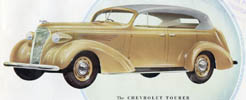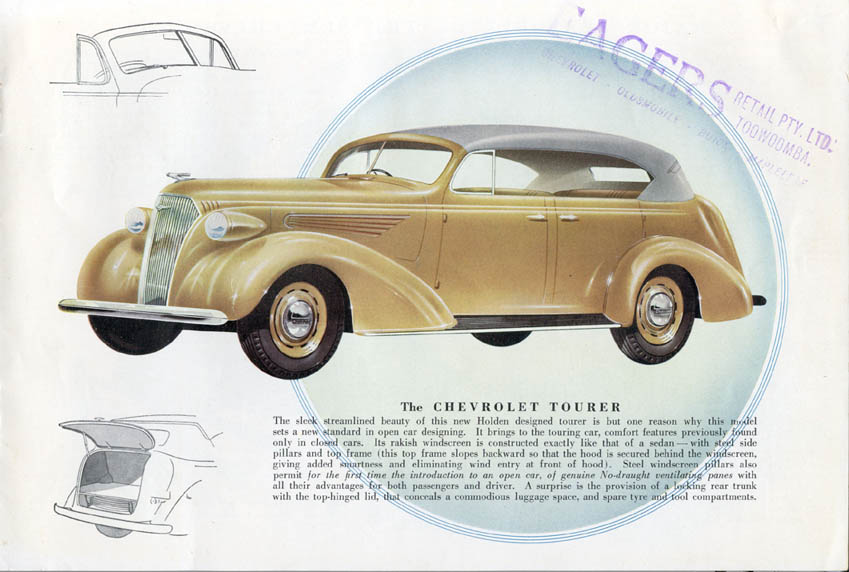 .
. 
Holden Roadster 459 total, Fisher Cabriolet 1724 produced, Holden Tourer 317 total
The Roadster and Cabriolet have been temporarily linked to the Tourer .
 .
.
.

Holden Roadster 459 total,
Fisher Cabriolet 1724 produced,
Holden Tourer 317 total
The first Chevrolet produced was the large 6 cylinder Touring car in 1911. Subsequently the Royal Mail Roadster and Baby Grand Touring were added to the line. In 1916, a hard, non removable top could be ordered with your touring car. Sedans cost twice as much and had the safety hazard of plate glass windows. Once the price of the closed car was equal to that of the soft top, No one in their right mind would suffer the summer sun or winter cold. The Touring and Roadster were moribund.
The 1934 (above) and 1935 (below) are believed to be the last years
a Phaeton (Touring car) was offered by Chevrolet. Both these vehicles
are in the Lemay Museum at Tacoma, Wash., as is the 36 below.
OK, now what's this pictured below? A 36 Phaeton
in Harold Lemay's attic? It is a Standard model with a lot
of accessories. Note the cowl is not a cut down sedan.
It is Left Hand Drive, Fisher (?) body so this rules out Australia,
South Africa (?), and England. All 4 doors are front hinged with
enclosed hinges. This is like the 34 & 35 standard phaetons.
It may be a prototype but why the different cowl? I have heard of
a single parade phaeton produced in 1936. Could this be it?
This ad is for a 36 Deluxe 4 door "Convertible Cabriolet"
with knee action. It's printed in German and states that it's made
at the Antwerp, Belgium factory. It appears to be on an "Imperial"
chassis that is longer than sedan. Unlike the 36 standard Phaeton
above, It has a fixed "V" windshield.
Chris Shead, of Australia, was kind enough to share his 37 Holden brochure
pictured below:


Note that this 38 is on a half ton chassis with unknown body maker.
The cowl is the same as that on my mail truck. All doors are
front hinged. Also note the large hub caps.
Below is 1936 & 39 European Fisher Phaetons. These were "Top
delete sedans" to save metal for WW II. Note that the fenders were
trimmed of some metal too. Note also the flat, fold down windshields.
I doubt they would invest the extra metal in an X-frame meaning the doors
would rattle from body flex. All European cars were required to have
Fender lights and Trafficators (Swing arm turn signals).
I have little info on European Chevs. If you have any information
about 37 or 38 Phaetons, It would go great right here.
The photo above was cut from a larger photo with
fifteen 1939 touring cars as long as you could see. I believe
these are also from Antwerp as they appear to have fender lights and trafficators
that where required on all European cars. They are left hand drive.
They appear to have a "B" pillar. I don't know if they have roll
up windows or side curtains.
I believe, Frans Vrijaldenhoven, of the Hague,
owns the 39 Convertible sedan below. The body number is 391267.
.
39 = 1939 model year, 12 = Master "85" with straight
axle, 67 = convertible coupe(??) It appears to have roll up
windows with removable "B" pillar.
The 41 convertible sedan below has roll up windows
and removable "B" pillar.
Touring Vanity

I am still trying to acquire more info about this vehicle.
Holden produced 27 Deluxe and 290 Standard Tourers. This is not very
many compared to all US Fisher Sedans which number 693,912.
Below is my Holden Tourer.
The small window in the top (hood) when up, makes visibility to the rear very limited. Since there is no top well, when the top is folded down, there is no rear visibility what so ever. I remove the top when I drive it to avoid backing over kangaroos.
The interior above is similar to mirror image of Fisher except for
gas pedal location.
The right side of the engine compartment is approaching modern day
standards for cramped. On the left, there's room to rent out.
Battery is under hood because of X-frame. The first few Tourers did
not have the X-frame and were recalled and retrofitted. It was thought
that the box frame would have the structural rigidity to withstand the
top chop. I have seen such a tourer with the battery under floor.
Mine has minimal body flex even on the roughest roads.
The chassis and fenders are the same as Fisher.
The rear luggage compartment lid is interchangeable with Fisher sedan,
but the stamping is obviously different. The body is Holden
of Australia. I am unsure of all the body styles Holden produced
for Chevrolet in 1937 but know of these. The Roadster is available
with Dickey (rumble) seat or Boot (Trunk). The
Sloper coupe (detailed on the coach page) offered a fold down back seat.
It would be decades till the USA would offer this convenience.
The Holden Sedan body was offered on Olds and Buick chassis. With
such low production, Holden couldn't produce "A", "B", & "C"
bodies like they did in the USA. I believe that this body was only
used on 1937 - 1938. The Tourer used a modified Sedan
body as there are places to bolt the window regulators under the door skins.
The cowl is obviously closed car derived.
There was a Roadster Utility (Pickup), a Coupe Utility and a Coupe Utility
with roadster doors. (See the UTE page for more info.) A
passenger based Panel-van (Sedan Delivery) was also available. (See the
Sedan Delivery page for details.) The
Panel trucks on truck chassis were also called Panel-Vans.
No coupes, no coaches, no Wagons, or no Cabriolets .

Repair tips
Coach
Taxis and limousines
Sedan Delivery
Coupe Pickup
Coupe
Sedan
Bus
Flxible
Station Wagons
Check out some other 2-Doors >>
Back to carz >>
View trux >>
Truck History
> >
Back Home >>>
Sorry, Still under construction!!![]()